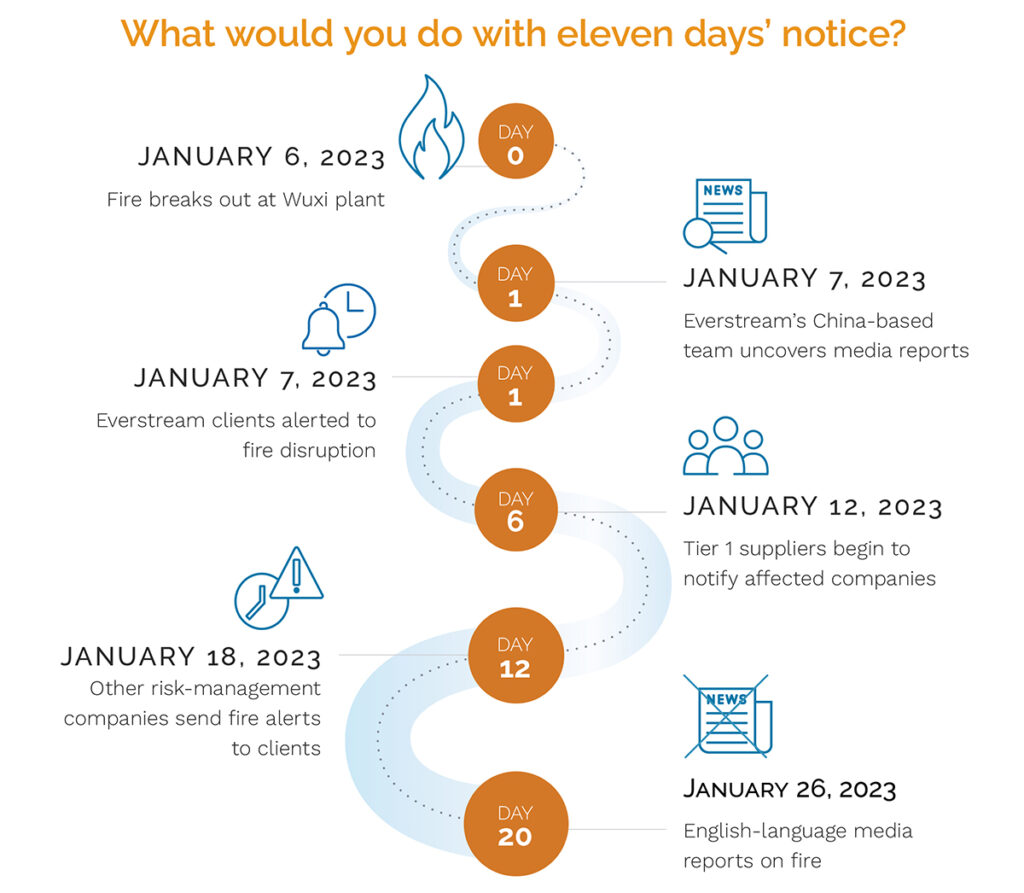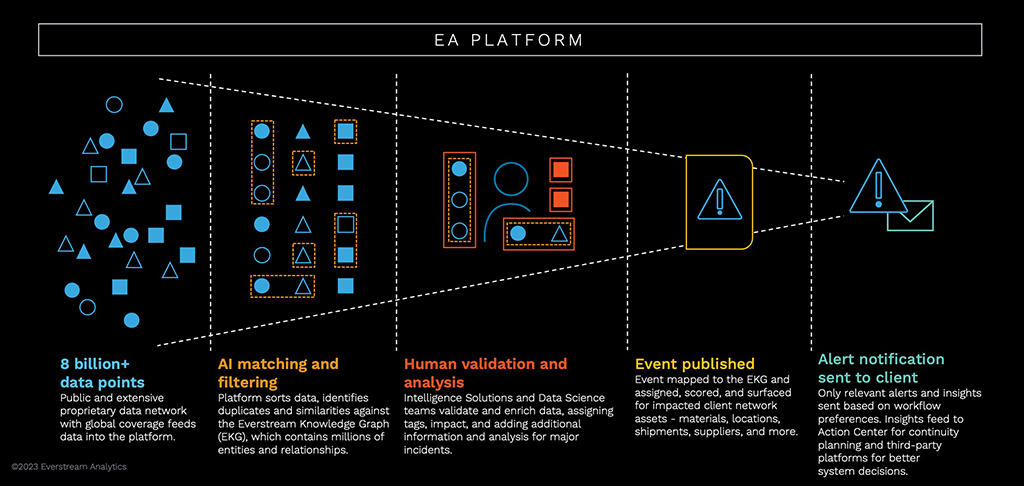With the rise of digital solutions including AI in supply chain risk management, more and more companies are leveraging technology to receive predictive and real-time supply chain alerts about potential supply chain disruptions. Whether the alert relates to a big regulation change, a supplier fire, or massive port congestion, supply chain managers must know about it before it becomes a problem, and way before reviewing the latest monthly out-of-policy report and reasons for delays.
Too many alerts can be overwhelming and create “alert fatigue” that leads to alert ignoring. Then when a critical alert arrives it might be overlooked. Here’s how to ensure that your operation receives only the right alerts at the right time.
Why supply chain alert relevance matters
The right supply chain alert can trigger consequent actions that generate massive value to an organization. Here’s an example: One of Everstream’s clients quickly acquired material and used rail-freight to send the shipment out of China at the start of COVID-19, which helped the company’s production plant to stay online for four more weeks and save millions.

Figure 1: Relevant supply chain alerts can buy companies valuable time when responding to supplier issues like the Wuxi production plant fire in China.
Relevant alerts can also help daily with ongoing port congestions. Alerts can help you plan shipments through the right ports, reducing airfreight costs by 5%. To get there, the business must accept the usefulness of alerts. But this is a tall order, when everyone’s email inbox is flooded with so many messages that you’re tempted to start the day by just mass deleting everything.
The truth is, technology isn’t perfect. There are several reasons why supply chain alerts can miss the mark on relevance:
Why media-monitoring solutions aren’t perfect
Many supply chain alert platforms are based on a media monitoring solution that is solely using a fuzzy matching algorithm. This technology often picks up the right type of alert for the wrong company, or generates irrelevant alerts for the right company. For example, we have seen companies getting alerts flagging articles about a soccer team of one of their suppliers. The algorithm chose the articles because the author used a lot of risk-related terminology when writing about the latest soccer match. A solution like this does not vet alerts for relevance before they are sent out, which means a high likelihood of lots of noise from many non-relevant alerts.
It is also important to note that social media companies like Twitter or Reddit are limiting access to data via APIs. Due to latest developments in API technology, user-generated content is becoming more valuable. This puts the longevity of media-monitoring solutions at risk as they run out of content.
Position-based alerts aren’t always relevant
The typical way an advanced supply chain risk management (SCRM) solution works is by building an intelligence team that verifies machine-learning results, aggregates results from different sources into one alert, and then sends it out to the customer.
The standard way of matching supply chain alerts with the customer network is to leverage geo-position and measure the distance of an alert to the network. Users can then filter alerts based on how close something is to the supply chain network, and by which types of alerts they will receive.
Compared to a media-monitoring solution, position-based alerts are more effective, but still provide some relevance challenges worth considering:
- If something happens to a company nearby a supplier in network, an alert will be sent out even if the supplier isn’t directly affected. This is especially problematic for facility fires or production outages.
- If a company is facing a cyber-attack or goes insolvent, what location does the alert pertain to? If it is tagged to the company’s headquarters, then the mapped supplier plant won’t show the alert. If the alert is mapped to every production plant of the supplier, then the visualization in the system is overloaded with alerts.
- How does the system flag regional events or countrywide events?
- How does the system send alerts for natural disasters that can start many miles away from mapped suppliers? Hurricanes and typhoons only go into one direction, so a distance-based system can trigger alerts for locations near a storm, but outside the storm’s actual path.
- Position-based alerting is the prevalent standard in the SCRM industry, but there are more modern approaches to achieve supply chain alert relevancy.
A modern context engine drives relevant supply chain alerts
Instead of relying on location-based or media-monitoring systems, today’s SCRM leaders are work with more sophisticated context engines. These platforms are tailored to drive alert relevance by customer use-case and type of alert. Here are some examples of how context engines enhance relevance:
- A cyber-attack alert delivered through AI technology will be vetted by humans to make sure there is a correct correlation between the alert and the company-mapped network.
- A civil unrest happening in a certain area of a city will be delivered as a shape drawn by an expert analyzing the situation to make sure alerts are not tagged to companies in a nearby commercial district that isn’t affected.
- A warning letter from the U.S. Food & Drug Association will only be sent to pharmaceutical customers who have mapped the mentioned supplier.
- A country-wide ban of chemical explosive imports right before a big sports event will only be sent to chemical companies with locations in the affected country.
This level of relevance improves stakeholder engagement because it lowers alert fatigue. A state-of-the-art context engine understands the type of alert, how to filter it, and the best manner of delivery, which combine to create user-based relevance.
When it comes to delivery, timing is also important. Some alerts are of systemic importance to your supply chain, so you need to know right away. Other risks can be bundled because your operation has enough buffer stock to accept a delay, so your team may choose to receive one mail with all updates every 8 hours, every 24 hours, or every week.

Figure 2: A combination of AI and human oversight ensures that Everstream’s supply chain alerts are relevant instead of adding to noise.
Every company’s and every person’s risk sensitivity is different, and context-based alerts can be adjusted to cater to all use cases. Of course, a company should begin by defining a risk appetite statement that makes clear what needs to be managed and what can be managed, and sets a corridor for each supply chain professional, who can then choose what to manage or not.
In a well-run context engine, an administrative-level user can then define all risks that are in scope for the company and the risk sensitivity levels. Other users can then opt out for some categories or apply to opt into others as well.
Leveraging user behavior to increase supply chain alert relevance
Even the best context engine cannot achieve satisfactory relevance without continuous customer feedback. It takes two to tango!
When onboarding a new platform, an open dialogue will help establish the needs and wants for your operation. Here, minute changes might not be enough, and your platform’s customer success and support teams should suggest improvements for leveraging data.
Once relevance for supply chain alerts is at a satisfactory level for your team, it’s time to roll out the system to the wider organization. From there, user behavior in the system and alert responses will drive further improvements to the profile over time. The context engine will provide recommendations that get vetted by the platform’s customer success and support teams, and can then be passed on to your team to evaluate.
Download our white paper to learn about risk scoring for supplier management
Ulf Venne leads the global Center of Excellence for Everstream Analytics. For the past 10 years he has helped clients improve supply chain risk management, and published articles and white papers on tools and methodologies for supply chain resilience, agility, and sustainability.